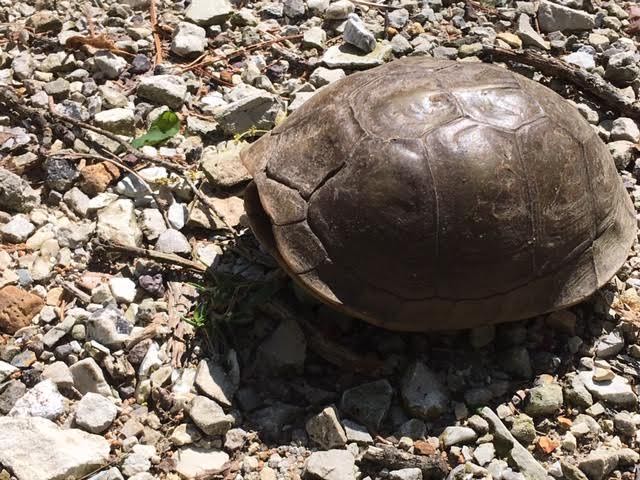Turtle Time
/The first box turtle of 2019 was conveniently crossing my driveway. (Photo by Charlotte Ekker Wiggins)
Turtle Time
It’s that time of year again when box turtles are on the move looking for love. Usually turtle season or turtle season in mid-Missouri starts closer to Mother’s Day but this year it is a couple of weeks early.
My first box turtle was walking across my own driveway. I was heading out to run errands and saw the traveler at the top of my gravel road. I couldn’t blame the turtle, it was a warm sunny spring day and even I was headed out.
When I got close, the turtle clammed up. Or turtled up, as one of my brothers used to call it, by pulling head and limbs back into its shell.
Box turtle closing up when I came close. (Photo by Charlotte Ekker Wiggins)
According to Missouri Department of Conservation, there are 17 kinds of turtles native to Missouri. The location of Missouri between the forested eastern United States and the prairies of the Great Plains has allowed plants and wildlife of the two regions to mingle. This is definitely the case with our two species of box turtle. The three-toed box turtle is closely related to a species found east of the Mississippi River, while the ornate box turtle has relatives to the west.
The name “box turtle” refers to the ability of this reptile to tightly close its shell when frightened. It does this by means of a hinge located across its lower shell. When startled, the turtle pulls its head and limbs into its shell for protection. Then it moves each half of the hinged lower shell up to meet the upper shell, thus closing like a box.
The name “terrapin” is often used for box turtles in Missouri, though it isn’t quite correct. The dictionary’s definition of the word terrapin refers to edible, aquatic turtles found in fresh and brackish waters of North America. Box turtles should not be considered edible, nor are they aquatic. However, the word terrapin is used by people of the British Isles to refer to any and all species of turtles. This could be the source of the word usage in southern Missouri.
To complicate the matter further, the scientific name (genus) of North American box turtles is Terrapene. In reality, our box turtles are closely related to semi-aquatic turtles found in rivers and wetlands, such as red-eared sliders and painted turtles.
A little spring treat to my garden visitor before I left him to enjoy it. (Photo by Charlotte Ekker Wiggins)
Both three-toed and ornate box turtles are fond of eating soft-bodied insects and earthworms, and the young of both species eat a higher percentage of these foods than anything else. However, there are some differences in the overall diets of the adults.
Adult three-toed box turtles eat more plant material and fruit than ornate box turtles. In the wild, they are known to eat strawberries, mulberries, black raspberries and blackberries. Mushrooms, tender shoots and flowers are also eaten.
Because box turtles live on land and eat plants, people often think of them as being small tortoises. This has led to the belief that box turtles live a very long time, maybe 100 years or more. Missouri’s species of box turtles actually live an average of 40 to 50 years.
A 25-year study of a population of three-toed box turtles in central Missouri by Charles and Libby Schwartz showed that the oldest specimen in a sample of over 1,700 was 59 years old.
There are times and circumstances when box turtles come in contact with people and, more often than not, it turns out poorly for these reptiles.
Many people who enjoy gardening have experienced box turtles getting into their crops of red, ripe strawberries or tomatoes. It’s easy to understand why box turtles frequently visit gardens in May and early June. There are few insects available at this time of year to eat, wild strawberries are scarce (and very small in size) and turtles are still trying to gain some weight after a long, over-winter dormancy. A garden with a nice crop of strawberries is too hard to resist for a hungry box turtle. Later in the summer, as tomatoes ripen, box turtles are attracted to the red color and the amount of moisture available in these fruits.
A simple solution to these problems is to build a low fence to keep box turtles and other wildlife out of the garden. Then, make sure the tomato plants have good, sturdy stakes or wire supports for climbing so that ripening fruit will be off the ground and out-of-reach of your neighborhood box turtles.
Relocating box turtles to new areas is not good for the reptiles. The new location may already have an established population with limited resources, and the transplanted turtles may not survive. Also, relocated wildlife have a strong urge to head back to where they came from, which can lead to them being killed on a road.
If you find a box turtle on a road, safely stop and move the turtle across the road in the direction it was travellng. Giving it a strawberry treat is purely optional!
Charlotte














